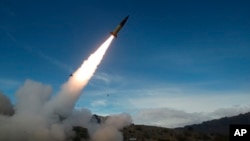Ukraine launched ATACMS at Russian forces on Tuesday, after the United States secretly provided a small number of the long-range ballistic missiles to Kyiv in recent days, Ukrainian President Volodymyr Zelenskyy said Tuesday, confirming earlier reporting from VOA.
"Our agreements with President [Joe] Biden are being implemented, and they are being implemented very accurately. ATACMS have proven themselves," Zelenskyy said Tuesday.
ATACMS which is short for the Army Tactical Missile System made by U.S. company Lockheed Martin, will allow Ukrainian forces to reach deeper into Russian-controlled territory. They also will allow Ukraine to fire at surface targets from a safer distance, rather than having to go to the front lines to hit targets farther back.
ATACMS can be used in High Mobility Artillery Rocket Systems or HIMARS that are already in Ukraine’s arsenal. Until now, the U.S. had provided only GMLRS — short for Guided Multiple Launch Rocket System — rockets for the system. GMLRS have a range of about 90 kilometers (60 miles).
A U.S. official who spoke to VOA on condition of anonymity said the U.S. had secretly provided Ukraine with a small number of the older variant of ATACMS, which has a maximum range of about 170 kilometers. (106 miles).
Newer versions of ATACMS have a maximum range of more than 300 kilometers (186 miles).
After initial decline, weapons approved
ATACMS are the latest in a string of weapons the Biden administration initially declined to provide Ukraine but changed its mind down the road. Kyiv had asked for the weapons system for more than a year.
The White House initially withheld approval for requests for American-made Stinger anti-aircraft missiles, High Mobility Artillery Rocket Systems and F-16 fighter jets, only to approve Ukraine’s ability to obtain those military assets later.
Last week, Secretary of Defense Lloyd Austin said the U.S. would co-lead the coalition that’s working to provide Ukraine with F-16 fighter jets, after greenlighting in May the training of Ukrainian pilots and the eventual transfer of the jets to Ukraine from Western allies. But Austin cautioned that it would take Ukraine "months" before they would be ready to use F-16s in battle.
"So earliest is next spring when we can begin to see an initial capability," Austin said.
Ukraine has intensified a campaign of missile and drone strikes to hit targets deep behind Russian lines, which has placed parts of the occupied Crimean Peninsula under repeated attack.
But with winter approaching, Ukrainian forces have yet to achieve a decisive breakthrough, a concern among Kyiv’s backers that has raised questions about the future of international support.
According to media reports, President Biden told Ukrainian President Volodymyr Zelenskyy last month that the U.S. would send a small number of ATACMS missiles to Ukraine in the coming weeks.
The United Kingdom had provided Ukraine with a similar type of missile earlier this year — the Storm Shadow missile, with a maximum range of about 250 kilometers — but the Storm Shadow is fired from a plane. With the skies over Ukraine highly contested, ATACMS can provide Ukraine with greater flexibility in its attacks.
The newest version of ATACMS also moves three to four times faster than other missiles seen on the battlefield, including the Storm Shadow and the Russian-made KH-101.
Additional military aid provided
News of the long-range missiles comes less than a week after the United States provided up to $200 million in additional military aid for Ukraine in a package the Pentagon said included weapons for air defense such as the AIM-9 Sidewinder missile, artillery munitions for HIMARS, TOW anti-tank missiles, and 155mm and 105mm rounds.
The package marked the 48th time that the U.S. has used the presidential drawdown authority to provide Ukraine’s military with equipment from U.S. stockpiles, and it was the first since Congress excluded new aid for Ukraine in a stopgap spending bill passed last month to prevent a government shutdown.
The U.S. has provided about $44 billion in security assistance to Ukraine since the beginning of Russia’s unprovoked invasion in February 2022.
The Pentagon still has about $5 billion of congressionally approved funding for Ukrainian military aid, after the Pentagon discovered in June that it had overestimated the value of weapons shipped to Ukraine by about $6 billion.
When calculating its aid package estimates, the Defense Department was counting the cost incurred to replace the weapons given to Ukraine, while it should have been totaling the cost of the systems actually sent, officials told VOA at the time the error was found.
Soon after the stopgap spending bill passed, the House ousted House Speaker Kevin McCarthy from his position as speaker.
The House has yet to elect a new speaker, and new aid for Ukraine could hinge on who is selected.








